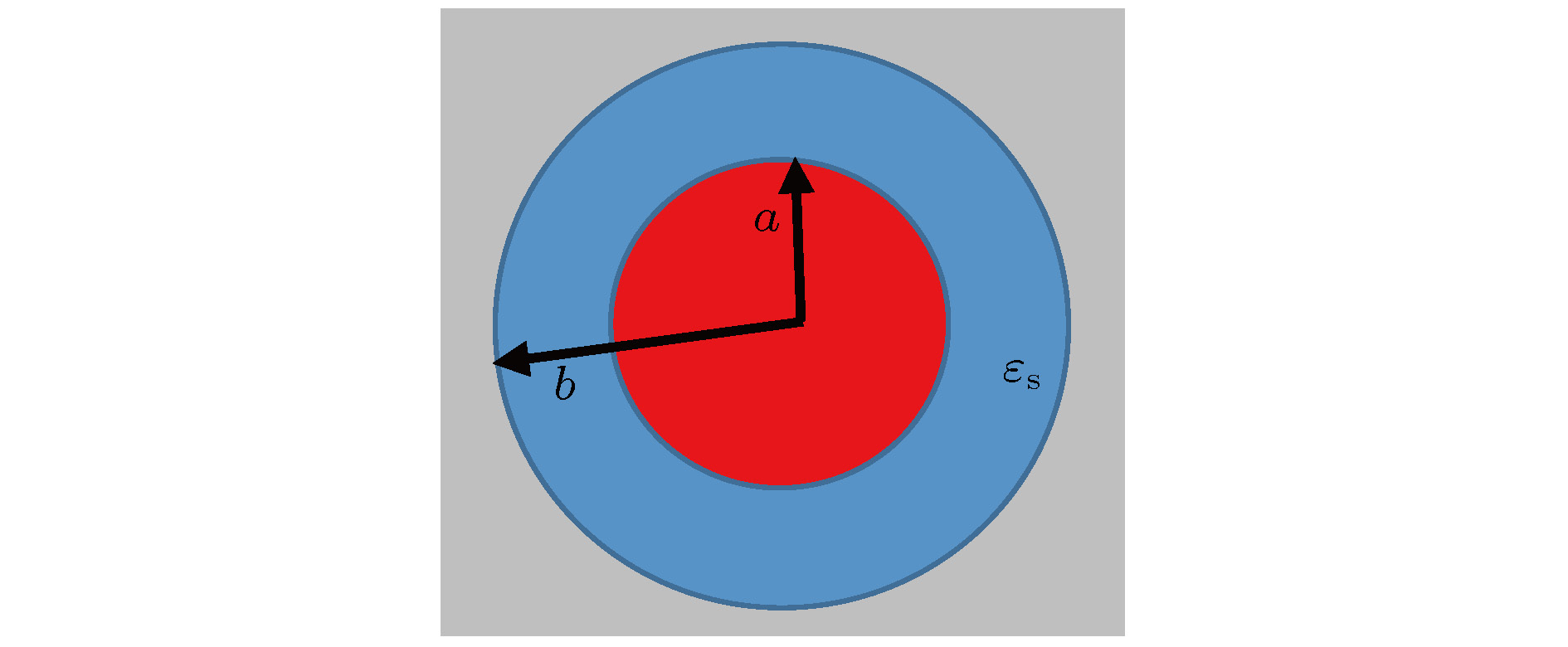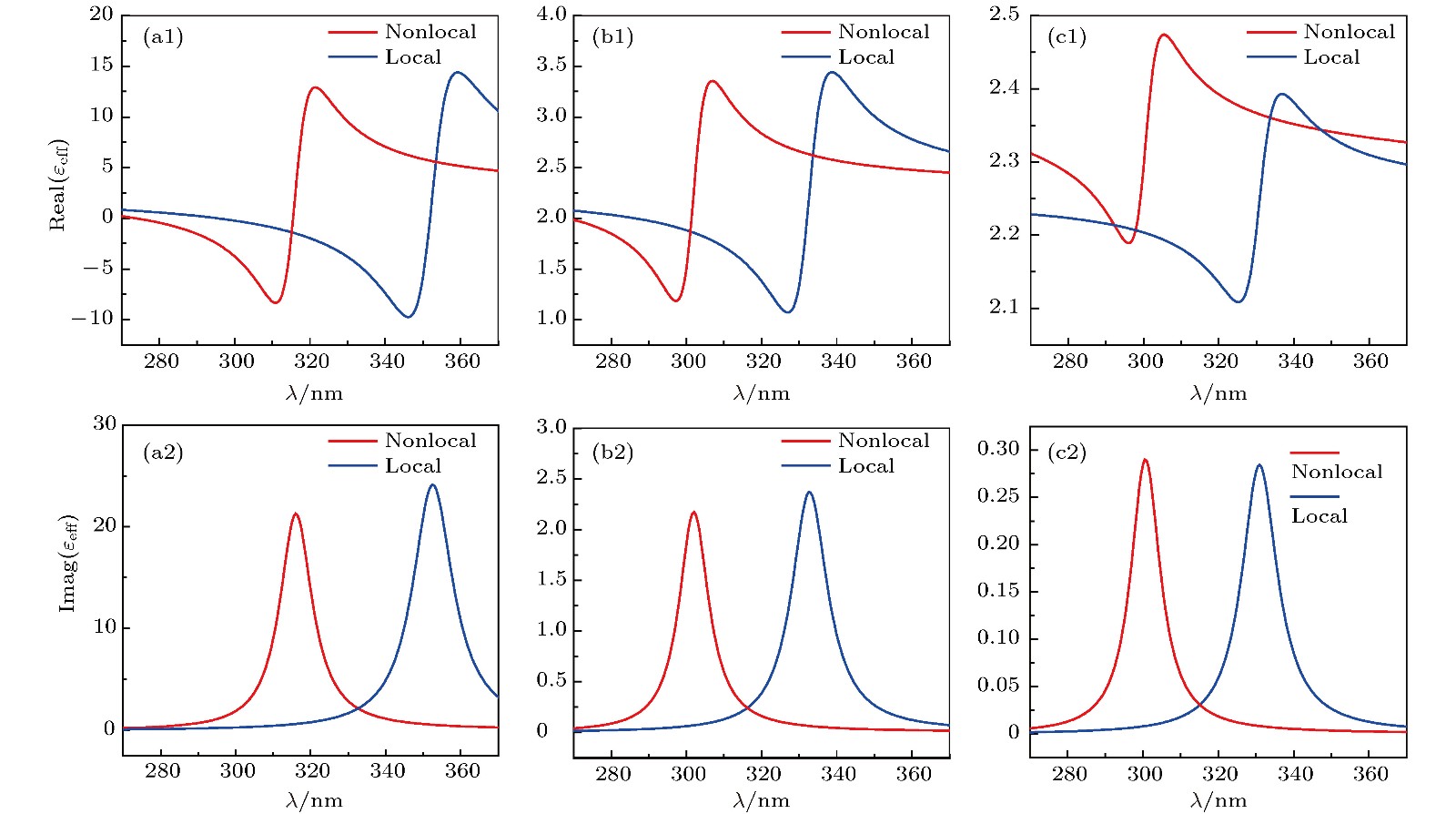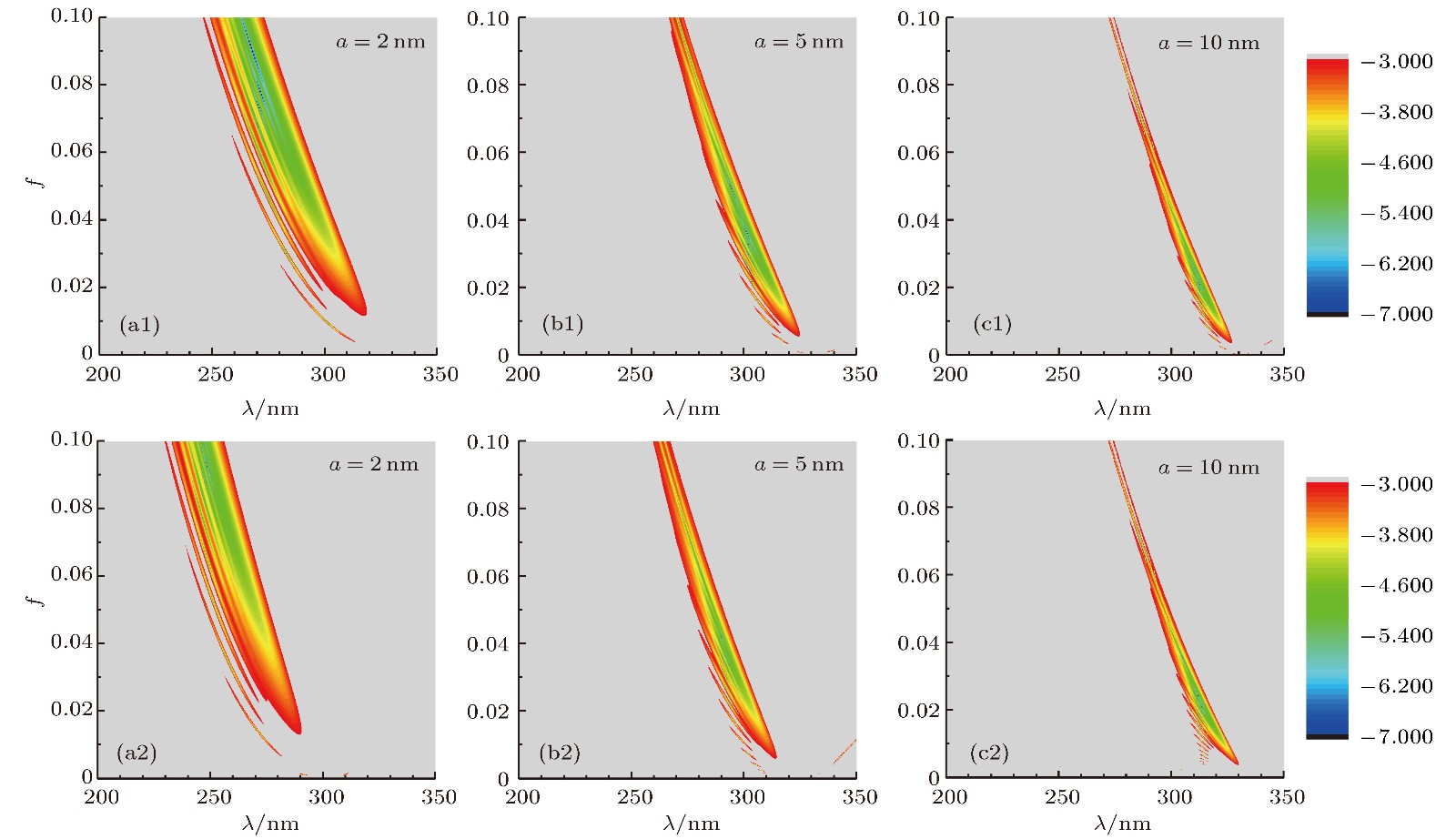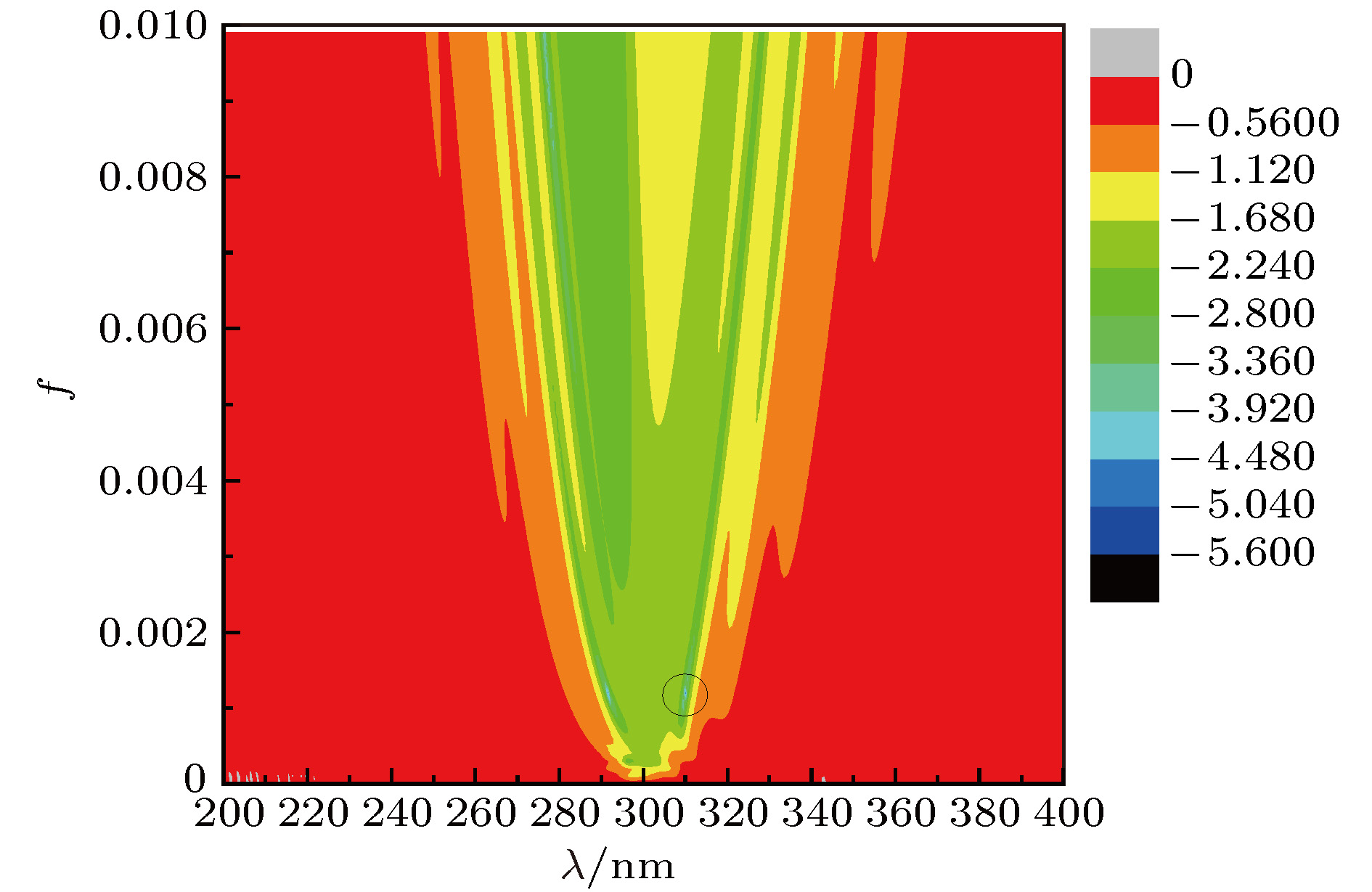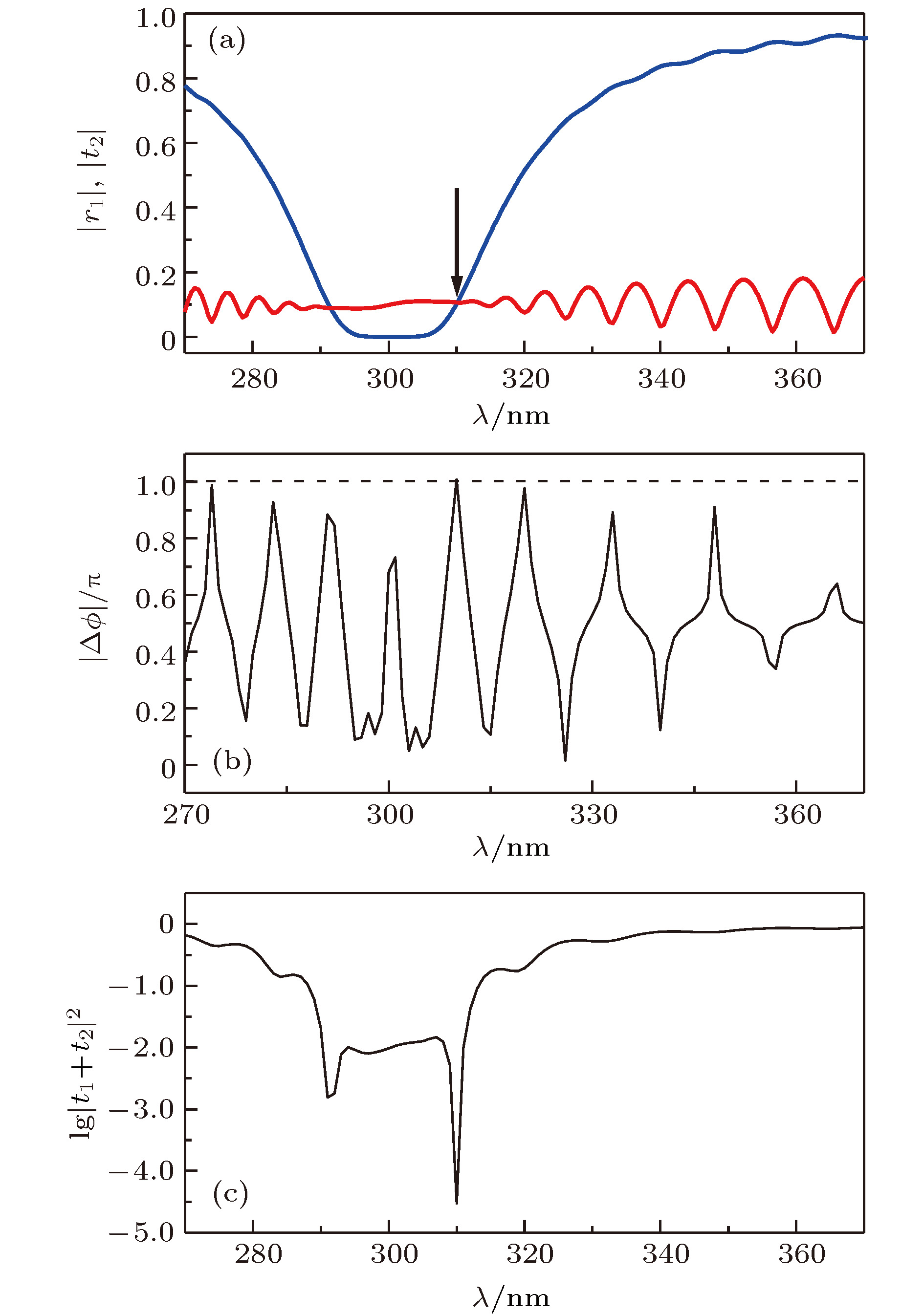-
研究了两束相干光以相同的入射角从左、右两侧分别入射到Au-SiO2复合介质板时, 在不同的体系参数下该复合材料体系发生相干完美吸收的情形. 运用有效媒质理论推导出了复合介质的有效介电常数以及有效磁导率; 在得到有效电磁参数的基础上进一步推导得到平面波入射复合介质板时的反/透射系数. 通过比较分析非局域和局域情况下颗粒复合介质的相干完美吸收现象, 发现当颗粒尺寸很小时非局域效应的影响会导致复合介质产生相干完美吸收的入射光的频率范围显著变宽. 在进一步的解析计算中, 通过调节复合介质板的厚度、入射光波长、金属颗粒体积分数等参数得到了不同情况下产生的相干完美吸收现象, 并由此分析非局域情形下对于相干完美吸收现象的调控.We explore the coherent perfect absorption of light in a nonlocal metal-dielectric composite film in which metallic nanoparticles (gold) are randomly embedded in the dielectric host medium (silica). The two coherent light beams illuminate the gold-silica composite slab respectively from the left and right sides at the same angle of incidence and the conditions required for coherent perfect absorption are investigated each as a function of different system parameters. Under different system parameters, we study the coherent perfect absorption of a nonlocal particle composite medium. A nonlocal effective medium theory is proposed to approximately describe the metal-dielectric composite film. The effective permittivity and effective permeability of the composite medium are approximated by using the effective medium theory under the model of coated sphere with core and shell. According to the effective dielectric parameters of the composite medium, we can obtain the transmission coefficient and reflection coefficient of the plane wave incident on the slab. By comparing and analyzing the coherent perfect absorptions of the composite medium under nonlocal and local conditions, we find that under the influence of nonlocal effect when the size of particle is very small, the frequency range of incident light that produces the coherent perfect absorption of the composite medium increases and the small size can also cause the coherent perfect absorption to occur in wider frequency range. Especially, we pay attention to the choosing of physical parameters in the design of coherent perfect absorption with macroscopic composite slab when we take the nonlocal effect (or spatial dispersion) into account. In the further calculation, the coherent perfect absorption of the composite medium can be realized by changing the system parameters such as the thickness of composite slab, the wavelength of incident light, the volume fraction of metal particles, etc. We also bring about the coherent perfect absorption at a small volume fraction which satisfies all the conditions. Finally, according to these results, we can realize the control of the coherent perfect absorption with nonlocal effect. Our study may be helpful in designing the optical nanoabsorbers.
[1] Dutta-Gupta S, Martin O J F, Gupta S D, Agarwal G S 2012 Opt. Express 20 001330
 Google Scholar
Google Scholar
[2] Sanjeeb D 2015 Opt. Commun. 356 515
 Google Scholar
Google Scholar
[3] Fu Y Y, Xu Y D, Chen H Y, Cummer S 2017 New J. Phys. 20 013015
 Google Scholar
Google Scholar
[4] Huang S, Xie Z W, Chen W D, Lei J Q, Wang F L, Liu K, Li L 2018 Opt. Express 26 7066
 Google Scholar
Google Scholar
[5] Müllers A, Santra B, Baals C, Jiang J, Benary J, Labouvie R, Zezyulin D A, Konotop V V, Ott H 2018 Sci. Adv. 4 eaat6539
 Google Scholar
Google Scholar
[6] Ruppin R 1973 Phys. Rev. Lett. 31 1434
 Google Scholar
Google Scholar
[7] Fuchs R, Claro F 1987 Phys. Rev. B 35 3722
 Google Scholar
Google Scholar
[8] Rojas R, Claro F, Fuchs R 1988 Phys. Rev. B 37 6799
 Google Scholar
Google Scholar
[9] Chang R, Leung P T 2006 Phys. Rev. B 73 125438
 Google Scholar
Google Scholar
[10] Xie H Y, Chung H Y, Leung P T, Tsai D P 2009 Phys. Rev. B 80 155448
 Google Scholar
Google Scholar
[11] Huang Y, Gao L 2013 Prog. Electromagn. Res. 133 591
 Google Scholar
Google Scholar
[12] Huang Y, Bian X, Ni Y X, Miroshnichenko A E, Gao L 2014 Phys. Rev. A 89 053824
 Google Scholar
Google Scholar
[13] McMahon J M, Gray S K, Schatz G C 2010 Nano Lett. 10 3473
 Google Scholar
Google Scholar
[14] Toscano G, Raza S, Jauho A P, Mortensen N A, Wubs M 2012 Opt. Express 20 4176
 Google Scholar
Google Scholar
[15] Zuloaga J, Prodan E, Nordlander P 2009 Nano Lett. 9 887
 Google Scholar
Google Scholar
[16] Esteban R, Borisov A G, Nordlander P, Aizpurua J 2012 Nat. Commun. 3 825
 Google Scholar
Google Scholar
[17] Dong T Y, Ma X K, Mittra R 2012 Appl. Phys. Lett. 101 233111
 Google Scholar
Google Scholar
[18] Stell L, Zhang P, García-Vidal F J, Rubio A, García-González P 2013 J. Phys. Chem. C 117 8941
 Google Scholar
Google Scholar
[19] Maxwell G J C 1906 Philos. Trans. Roy. Soc. London 205 237
 Google Scholar
Google Scholar
[20] Bruggeman D A G 1935 Ann. Phys. (Leipzig)
24 636  Google Scholar
Google Scholar
[21] Huang Y, Gao L 2013 J. Phys. Chem. C 117 19203
 Google Scholar
Google Scholar
[22] Dias E J C, Iranzo D A, Gonçalves P A D, Hajati Y, Bludov Y V, Jauho A P, Mortensen N A, Koppens F H L, Peres N M R 2018 Phys. Rev. B 97 245405
 Google Scholar
Google Scholar
[23] Agarwal G S, O'Neil S V 1983 Phys. Rev. B 28 487
 Google Scholar
Google Scholar
[24] Mcmahon J, Gray S, Schatz G 2009 Phys. Rev. Lett. 103 097403
 Google Scholar
Google Scholar
[25] Dasgupta B B, Fuchs R 1981 Phys. Rev. B 24 554
 Google Scholar
Google Scholar
-
图 3 (a1) f = 0.1, (b1) f = 0.01, (c1) f = 0.0012时有效介电常数的实部; (a2) f = 0.1, (b2) f = 0.01, (c2) f = 0.0012时有效介电常数的虚部随
$\lambda $ 的变化; 此时d为5${\text{μ}}{\rm m}$ , a为2 nmFig. 3. (a1), (b1) and (c1) are the real parts of effective permittivity as function of
$\lambda $ , for (a1) f = 0.1, (b1) f = 0.01, (c1) f = 0.0012; (a2), (b2), (c2) are the imaginary parts of effective permittivity as function of$\lambda $ , for (a2) f = 0.1, (b2) f = 0.01, (c2) f = 0.0012. d = 5${\text{μ}}{\rm m}$ , a = 2 nm.图 4 (a1), (b1), (c1) a = 2, 5, 10 nm时, 局域效应下
$\lg|r_1+t_2|^2$ 与$\lambda $ 和f的函数关系; (a2), (b2), (c2)对应情况下考虑非局域效应时的结果; 入射角$\theta$ = 45°Fig. 4.
$\lg |r_1 \!+\! t_2|^2$ as functions of$\lambda $ and f with different metallic nanoparticle radius (a) a = 2 nm, (b) a = 5 nm, (c)a = 10 nm: (a1), (b1) and (c1) are within the local description and (a2), (b2) and (c2) are within the nonlocal description. The incident angle is$\theta$ =45°.图 5 (a) d = 2
${\text{μ}}{\rm m}$ , (b) d = 5${\text{μ}}{\rm m}$ , (c)、d = 10${\text{μ}}{\rm m}$ 时散射光强对数${\log _{10}}{\left| {{r_1} + {t_2}} \right|^2}$ 与$\lambda $ 和f的函数关系图, 此时入射角$\theta $ 为45°Fig. 5.
${\log _{10}}{\left| {{r_1} + {t_2}} \right|^2}$ as functions of$\lambda $ and f with thickness of medium plate (a) d = 2${\text{μ}}{\rm m}$ , (b) d = 5${\text{μ}}{\rm m}$ , (c) d = 10${\text{μ}}{\rm m}$ . The incident angle is$\theta $ = 45°.图 7 f = 0.0012,
$\theta $ = 45°时, (a)$\left| {r_1 } \right|$ (蓝色)、$\left| {t_2 } \right|$ (红色)与$\lambda $ 的函数关系, (b)$\left| {\Delta \phi } \right|/{\text{π}}$ 与$\lambda $ 的函数关系, (c)${\log _{10}}{\left| {{r_1} + {t_2}} \right|^2}$ 与$\lambda $ 的函数关系Fig. 7. For f = 0.0012,
$\theta $ = 45°, (a)$\left| {r_1 } \right|$ (blue),$\left| {t_2 } \right|$ (red) as function of$\lambda $ , (b)$\left| {\Delta \phi } \right|/{\text{π}}$ as function of$\lambda $ , (c)${\log _{10}}{\left| {{r_1} + {t_2}} \right|^2}$ as function of$\lambda $ .图 8
$\lambda $ = 310 nm,$\theta = 45^\circ $ 时, (a)$\left| {r_1 } \right|$ (蓝色),$\left| {t_2 } \right|$ (红色)与f的函数关系; (b)$\left| {\Delta \phi } \right|/{\text{π}}$ 与f的函数关系; (c)${\log _{10}}{\left| {{r_1} + {t_2}} \right|^2}$ 与f的函数关系Fig. 8. For
$\lambda $ = 310 nm,$\theta = 45^\circ $ , (a)$\left| {r_1 } \right|$ (blue),$\left| {t_2 } \right|$ (red) as function of f, (b)$\left| {\Delta \phi } \right|/{\text{π}}$ as function of f, (c)${\log _{10}}{\left| {{r_1} + {t_2}} \right|^2}$ as function of f. -
[1] Dutta-Gupta S, Martin O J F, Gupta S D, Agarwal G S 2012 Opt. Express 20 001330
 Google Scholar
Google Scholar
[2] Sanjeeb D 2015 Opt. Commun. 356 515
 Google Scholar
Google Scholar
[3] Fu Y Y, Xu Y D, Chen H Y, Cummer S 2017 New J. Phys. 20 013015
 Google Scholar
Google Scholar
[4] Huang S, Xie Z W, Chen W D, Lei J Q, Wang F L, Liu K, Li L 2018 Opt. Express 26 7066
 Google Scholar
Google Scholar
[5] Müllers A, Santra B, Baals C, Jiang J, Benary J, Labouvie R, Zezyulin D A, Konotop V V, Ott H 2018 Sci. Adv. 4 eaat6539
 Google Scholar
Google Scholar
[6] Ruppin R 1973 Phys. Rev. Lett. 31 1434
 Google Scholar
Google Scholar
[7] Fuchs R, Claro F 1987 Phys. Rev. B 35 3722
 Google Scholar
Google Scholar
[8] Rojas R, Claro F, Fuchs R 1988 Phys. Rev. B 37 6799
 Google Scholar
Google Scholar
[9] Chang R, Leung P T 2006 Phys. Rev. B 73 125438
 Google Scholar
Google Scholar
[10] Xie H Y, Chung H Y, Leung P T, Tsai D P 2009 Phys. Rev. B 80 155448
 Google Scholar
Google Scholar
[11] Huang Y, Gao L 2013 Prog. Electromagn. Res. 133 591
 Google Scholar
Google Scholar
[12] Huang Y, Bian X, Ni Y X, Miroshnichenko A E, Gao L 2014 Phys. Rev. A 89 053824
 Google Scholar
Google Scholar
[13] McMahon J M, Gray S K, Schatz G C 2010 Nano Lett. 10 3473
 Google Scholar
Google Scholar
[14] Toscano G, Raza S, Jauho A P, Mortensen N A, Wubs M 2012 Opt. Express 20 4176
 Google Scholar
Google Scholar
[15] Zuloaga J, Prodan E, Nordlander P 2009 Nano Lett. 9 887
 Google Scholar
Google Scholar
[16] Esteban R, Borisov A G, Nordlander P, Aizpurua J 2012 Nat. Commun. 3 825
 Google Scholar
Google Scholar
[17] Dong T Y, Ma X K, Mittra R 2012 Appl. Phys. Lett. 101 233111
 Google Scholar
Google Scholar
[18] Stell L, Zhang P, García-Vidal F J, Rubio A, García-González P 2013 J. Phys. Chem. C 117 8941
 Google Scholar
Google Scholar
[19] Maxwell G J C 1906 Philos. Trans. Roy. Soc. London 205 237
 Google Scholar
Google Scholar
[20] Bruggeman D A G 1935 Ann. Phys. (Leipzig)
24 636  Google Scholar
Google Scholar
[21] Huang Y, Gao L 2013 J. Phys. Chem. C 117 19203
 Google Scholar
Google Scholar
[22] Dias E J C, Iranzo D A, Gonçalves P A D, Hajati Y, Bludov Y V, Jauho A P, Mortensen N A, Koppens F H L, Peres N M R 2018 Phys. Rev. B 97 245405
 Google Scholar
Google Scholar
[23] Agarwal G S, O'Neil S V 1983 Phys. Rev. B 28 487
 Google Scholar
Google Scholar
[24] Mcmahon J, Gray S, Schatz G 2009 Phys. Rev. Lett. 103 097403
 Google Scholar
Google Scholar
[25] Dasgupta B B, Fuchs R 1981 Phys. Rev. B 24 554
 Google Scholar
Google Scholar
计量
- 文章访问数: 12956
- PDF下载量: 85
- 被引次数: 0














 下载:
下载:
